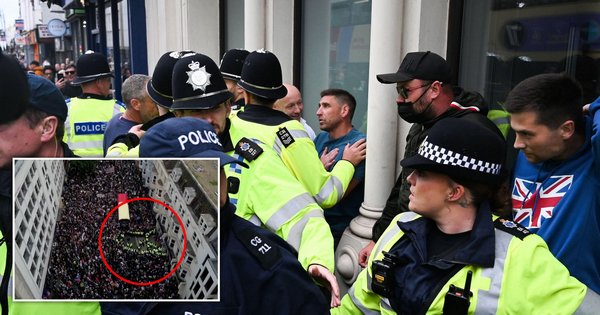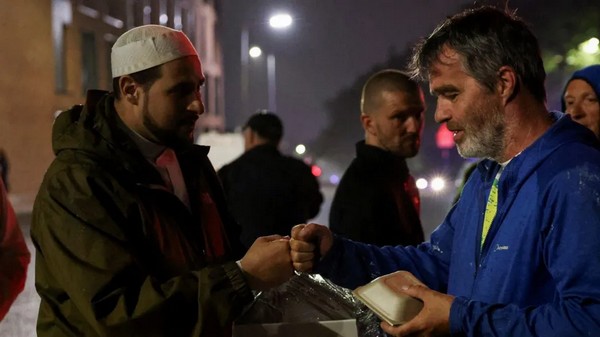Extreme reaction

Wednesday, 14 August found me on a day’s family excursion to Brighton, particularly to visit the exaggerated opulence of the Royal Pavilion. An edifice, if ever there was one, symbolising the class division of society.
This Regency Pavilion was built in the latter part of the eighteenth and early nineteenth centuries, a time of dramatic economic change in Britain. This early period of the industrial revolution would witness the emergence of the Luddites and a perception by the British state of a danger of insurrection. Machine breaking and mill burning caused the authorities to respond with force and punitive punishments, up to and including capital sentencing. There was much talk of shadowy influences, such as ‘General Ludd’, orchestrating these outrages.
Riots were a feature of affairs in the eighteenth century. Between 1756 and 1757, stores and shipments of food were looted. Again in 1766, poor harvests and the consequent rising price of wheat and corn resulted in riots across England; 131 recorded between September and the following August. The government reacted, in those pre-police force days, by deploying military units. Large numbers of people were arrested and eight shot dead. Special commissions of assizes were set up that imposed sentences including hanging, transportation or imprisonment.
If these sentences were intended to deter future outbreaks they failed. There were further such riots between 1770 and 1774. This was the period just before the building of the Royal Pavilion.
Ready-made headlines
Walking from the railway station I had a brief conversation with a couple who had come into Brighton to visit a particular shop. Originally their intention had been to arrive later in the day, but the shop was planning to close at 3 that afternoon. The rioters, it seemed, were on their way. Not eighteenth century rioters looking for cheaper bread, but twenty-first century malcontents demanding that immigrants and immigration be dealt with. The tragic murder of three young girls in Southport had been hijacked, largely via social media, by malicious individuals and groups.
Immigrants, especially those who had arrived uninvited on England’s shores in inflatable small boats, were extrajudicially condemned by minority opinion of guilt by association with that dreadful murder. That the one arrested was not an immigrant proved immaterial. For nights running, firstly in Southport, then across England more widely, a number of immigrant accommodations were besieged, as also, as in Southport, were mosques; Muslim equals immigrant seems to have been the ‘logic’.
The disturbances gave the media ready-made headlines and stories for the August period traditionally referred to as the silly season by the media. Parliament is not sitting, so while there is terrible news from abroad, domestic issues are in short supply. A few riots provide dramatic footage for the TV news channels, and are a gift for journalists to report and opine about. Watching footage of howling mobs confronting lines of police generates feelings of insecurity and reinforces the notion that society faces perpetual threats.
Far right and far left
Following the recent elections in France in the first round of which populist nationalism triumphed, only to be thwarted in the second by an alliance of convenience of liberals, social democrats and what’s termed the far left, it was inevitable that participants in the riots would be labelled extreme right.
Left and right are exceedingly broad political categories, designations that emerged in the national assembly of eighteenth century revolutionary France. So broad that extreme right easily covers neo-nazis/fascists, demagogic nationalists, racists and such like. Far left encompasses those who adhere to some degree or other of Leninist organisation of which there are many and various. Most claim to be socialist, though not advocates of a post-capitalist worldwide moneyless commonwealth based on the principle of meeting everyone’s needs.
The problem with the left and right designations is that there is no actual intention of ridding society of capitalism, as they are descriptive of relative political positions within capitalism. Left socialist? Right fascist? What about national socialists? Right-wing socialists? Left-wing Nazis?
What comes through is the confusion of ideas, a confusion helping to maintain capitalism by keeping people divided. It has the effect of focusing most political vision myopically on that other political category, the centre, as the alternative. Offering the alternative to capitalism that socialism is demands going beyond these political categories and an engagement by the vast majority of people to consciously challenge and then transcend capitalism, overthrowing by democratic means the apparent necessity of the status quo.
Underlying insecurity
Undoubtedly, those who took an active part in the various disturbances were motivated by a variety of reasons. However, like those in the eighteenth century food riots, the basic cause is economic. In present-day society only a privileged few prosper, most experience financial insecurity and some suffer downright poverty. Those with very little are fearful of losing the little they do have.
Dr Abdul Hamid, chairman of the Abdullah Quilliam Mosque in Liverpool, confronted by demonstrators, recognised underlying insecurity as the basic problem. Then ‘the other’ is perceived as a threat, those who are seen to be outside limited perspectives. Dr Hamid said there is a ‘fear of the unknown’ and ‘if they don’t get answers, they will try to find any excuse to label you’. Adam Kelwick, a mosque volunteer, went on to say of the demonstrators, ‘I don’t think they knew what they were protesting about – I think they’re just angry, fed up.’
Mosque members made a point of meeting rather than confronting those outside. Conversations took place and food rather than half bricks were exchanged. Then, Kelwick went on to point out, ‘Some of the most vocal protesters, after everyone else had gone, came inside the mosque for a little tour’.
Extreme rightists? Or those with ill-defined grievances who got caught up in something that, for a while, got out of control. As Kelwick observed, ‘None of the people I spoke to mentioned Southport’.

The good news
In a Brighton pub for lunch I overheard the manager on the phone confirming they were definitely closing at 6 that evening. Later that afternoon, walking back to the railway station I saw a number of shops being boarded up. That evening it seems there was an outbreak of nothing happening: no riots, no confrontations. The news featured the Prime Minister vowing judicial punishment for all participants in disturbances. He may have to reintroduce capital sentences and transportation to be true to his word, as the prisons, it seems, are already near enough full.
The good news is that very quickly there were far more diverse groups of people declaring their common humanity with migrants, than the very much smaller numbers of antagonists. Although reported, this was nowhere near as big a story. Bad news is more dramatic it seems.
For the immigrants who were targeted it was a highly distressing few days. Those involved in the riots should ask themselves why people put themselves through all the hardships of migration. They might realise that they have more in common economically with migrants than what seems to divide them. Certainly, one overwhelming common interest that all but the privileged few has, migrant, demonstrator and those watching on TV, is in removing capitalism, the insecure society that of itself breeds riot and social disturbance.
DAVE ALTON
